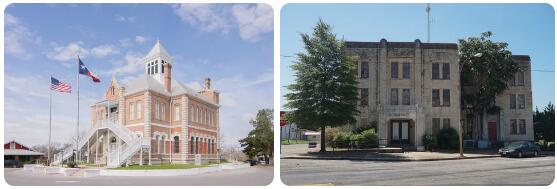
Anderson County is located in East Texas and is home to nearly 58,000 people. It was named after Kenneth L. Anderson, a prominent Texas politician and governor. The county was established in 1846 and has a total area of 1,037 square miles.
The county seat is Palestine, which was named after the biblical city of the same name by early settlers in the area. Anderson County is known for its rolling hills and lush forests, which are home to many species of wildlife including white-tailed deer, wild turkey and armadillos.
The economy of Anderson County is largely based on agriculture and oil production. In particular, cotton production has been a major part of the county’s economy since its establishment in 1846. Other crops grown in the area include corn, soybeans, wheat and hay. Oil production has also been an important part of the local economy since oil was discovered in 1915 near Palestine.
The cities of Palestine, Elkhart and Frankston are all located within Anderson County’s boundaries. Palestine is the largest city with a population of over 18,000 people while Elkhart has around 2,500 residents and Frankston about 1,600 people. All three cities offer a variety of attractions including historic sites such as Fort Parker State Park where Davy Crockett lived during his time in Texas; museums such as The Museum for East Texas Culture; recreational activities like canoeing on Lake Palestine; and festivals such as The Dogwood Trails Festival which celebrates springtime blooms throughout the region each April.
Education is also important to Anderson County residents with several public schools located within its borders including two high schools (Palestine High School and Elkhart High School), four middle schools (Palestine Middle School, Elkhart Middle School, Belton Middle School and Frankston Middle School) as well as numerous elementary schools serving students from kindergarten through fifth grade.
Anderson County offers something for everyone whether you’re looking for outdoor adventure or just want to relax among nature’s beauty – it truly is an ideal place to live or visit.
History of Anderson County, Texas
Anderson County, Texas is located in east central Texas and is one of the original 254 counties established by the Republic of Texas in 1846. It was named after Kenneth Lewis Anderson, a soldier and politician who served in the Texas Revolution.
The earliest settlers to Anderson County were Native Americans who had lived in the area for hundreds of years before the arrival of Europeans. In 1820, a small settlement was established near what is now Palestine and by 1840 the population had grown to over 1,000 people.
The 1850s saw an influx of settlers from other states such as Mississippi, Alabama and Tennessee. They quickly established farms and ranches throughout Anderson County which soon became a thriving agricultural community. Cotton was the primary crop grown in Anderson County during this period as well as corn, wheat, oats and other grains.
The Civil War brought great upheaval to Anderson County with many residents joining Confederate forces or being conscripted into service against their will. After the war ended Reconstruction began but it proved to be difficult for many former slaves who were not allowed to own land or vote until 1870 when African-Americans were granted full citizenship rights in Texas.
In 1871, railroads came to Anderson County which helped spur economic development and population growth throughout the county. The railroads allowed farmers to ship their crops more easily as well as allowed new businesses such as sawmills, grist mills, creameries and ice houses to be established in towns like Palestine and Elkhart.
In addition to farming and ranching, timber harvesting became an important industry during this time with several large logging companies operating within Anderson County’s borders. By 1900 there were over 20 sawmills operating within Anderson County providing much needed jobs for local residents while also fueling economic growth throughout East Texas.
By 1930, oil was discovered in parts of East Texas which led to a boom period for many towns including Palestine which became known as “the Oil Capital of East Texas” due its large number of oil wells located within its city limits. This led to further economic growth throughout Anderson County with new businesses springing up all over including banks, hotels, restaurants and stores catering to those looking for work or looking for goods related to oil production or drilling operations.
Today, Anderson County remains an agricultural center but has diversified its economy slightly with tourism becoming increasingly important due its proximity to Lake Palestine and other nearby attractions such as Tyler State Park or Fort Parker Historic Site where visitors can learn about early life in East Texas during pioneer days prior 1900s.